Dell XPS 13 review (2015): Meet the world's smallest 13-inch laptop

CES has come and gone; the holidays are long past; and now all we're left with are a few months of dreary weather. No fun, right? Right. Except if you're a tech writer. Now that most major companies have revealed their new lineups, we have the exciting job of testing all this stuff; seeing how it holds up in real life. The first product of the year to cross my desk: none other than the Dell XPS 13, a compact 13-inch laptop that ranked as a finalist for our annual Best of CES awards. In addition to being the first system we've tested with Intel's new fifth-generation Core processor, the redesigned XPS is notable for its nearly bezel-less display -- a design feat that allows it to have the footprint of an 11-inch machine. Particularly with a starting price of $800 (pretty reasonable for a flagship laptop), it seemed poised to become one of our new favorite Ultrabooks. And you know what? It actually is.
Hardware
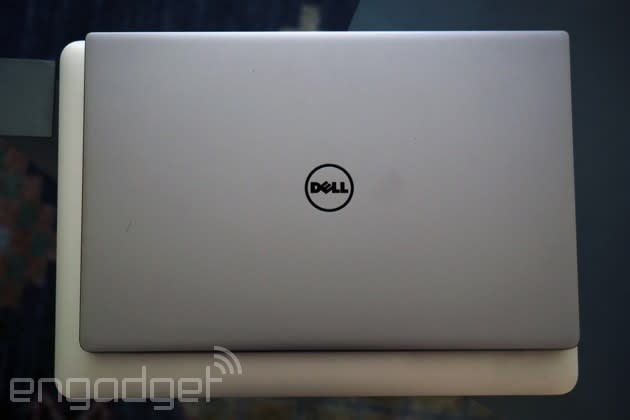
I suspect many people will buy the XPS 13 purely because of that gorgeous screen, but personally, after using the laptop for a week, I'm more impressed with how small it is. To be fair, of course, I'm a little late to the game: Netbooks and 11-inch laptops have been around for years, but until now, I've avoided them precisely because I prefer the extra screen real estate. That said, with a display this big, the XPS 13 feels like the best of both worlds. Especially for frequent travelers like me. Take my recent cross-country flight to Seattle. The laptop took up less space in my backpack than my MacBook Air would have. It was easier to balance on a cramped airplane tray, even with the person in front of me leaning all the way back (thanks, dude). And for those moments when I had to put my laptop out of sight, it was small enough that I could stow it inside the seat-back compartment with room to spare. At the same time, I had enough space to juggle multiple browser tabs, as well as WordPad in a separate window. After a week with the XPS 13, I'm reminded that weight and thinness aren't everything, though it definitely helps that this thing starts at just 2.6 pounds. Not bad for a 13-inch laptop! (Even with the optional touchscreen, it's still 2.8 pounds.)
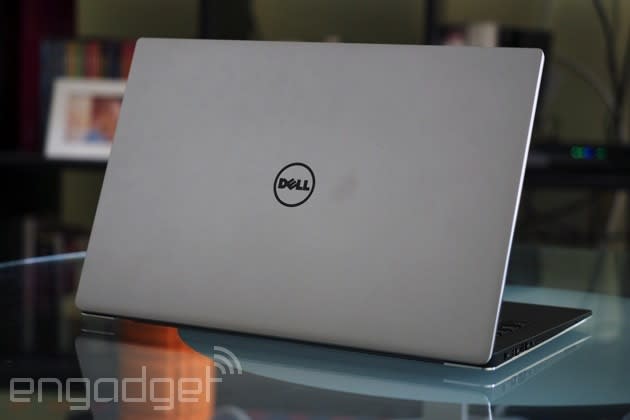
Other than the smaller footprint and nearly bezeless screen, the XPS 13 hews to the same design language as Dell's previous Ultrabooks. Which is to say, it features a smooth metal exterior, with details that include a metal plate on the bottom side to cover up all the required FCC fine print. On the inside, a soft carbon fiber finish stretches across the keyboard deck all the way from the hinge to the palm rest. It's a design that's both beautiful and practical, and I'm glad Dell didn't mess with a good thing just for the sake of shaking things up. For one thing, the carbon weave is nice to look at. Disagree with me if you like, but I think it instantly makes this $800 machine look more expensive than it actually is. It feels nice too, especially if you have the laptop on a flat surface and are letting your wrists hang off the palm rest. Also, thanks to that weave pattern, scratches are virtually a non-issue. Fingerprints too. (The keyboard is another story: I've got a big grease stain on the space bar, where my thumb keeps hitting it.)
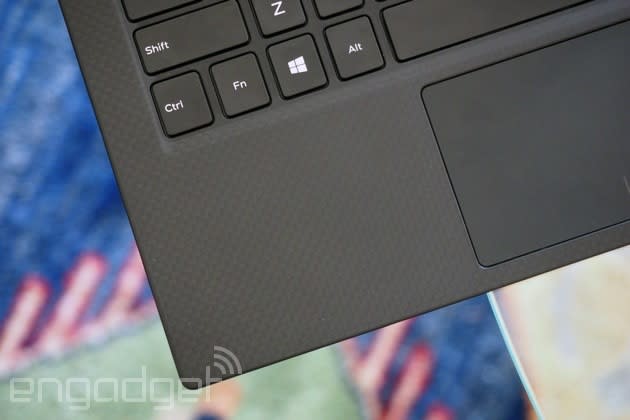
Speaking of the keyboard, I really like it, even if it does require a bit of upkeep to keep the fingerprints away. Despite the XPS 13's compact footprint, this feels like a full-sized layout. Though there are a few shrunken buttons (backspace, for example), most of the backlit keys feel generously sized and well-spaced. Even the arrow keys are easy to find by feel, and those are usually the first things to get squeezed when space is an issue. The buttons also have a surprising amount of travel compared to some other Ultrabooks, with a springiness that made it easy for me to type at a fast clip. My only quibble is that the keyboard sometimes failed to register my button presses, forcing me to go back and re-type stuff. To be honest, though, this is an issue on many Ultrabooks; in fact, it's probably less of a problem here, what with those relatively cushy buttons.
I won't go so far as to say I hate the Microsoft-made Precision touchpad, but it's definitely not as well-engineered as the keyboard. There's just a little too much friction, to the point where I noticed some stuttering even while doing basic two-finger scrolling (that's not just in IE, but in apps like File Explorer and WordPad too). Pinch-to-zoom also didn't feel as controlled as on some other Windows PCs; it sometimes took me multiple attempts to scale text exactly the way I wanted. One time, I actually zoomed in on a webpage by accident when all I meant to do was scroll through. On the bright side, the trackpad does well at single-finger tracking -- an area where other laptop touchpads frequently fall short.
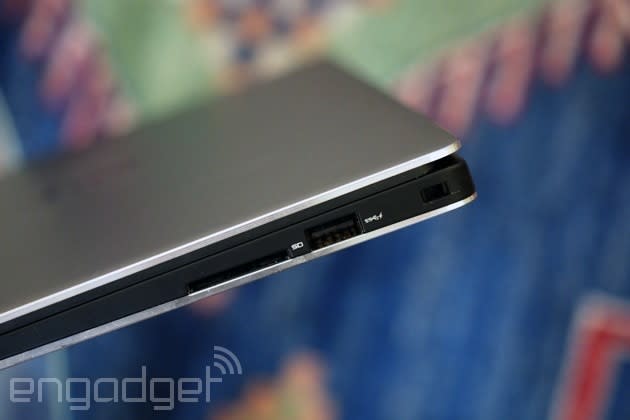
Though it's a smaller-than-average machine, the XPS 13 thankfully still includes all the usual ports. Well, most of them anyway. Over on the left side, we have a Mini DisplayPort, a headphone jack, one of two USB 3.0 connections and the all-important power socket. The right edge is less crowded, with a Kensington lock slot, a full-sized SD card reader and that second USB opening. There's also an HD webcam, nestled in the lower-left corner below the screen (clearly, Dell had to get creative to accommodate those skinny bezels). Really, of all the things you might reasonably expect to find on an Ultrabook, the only thing missing is an HDMI port. Even then, I suspect many of you will do just fine without it. I know I have.
Display and sound
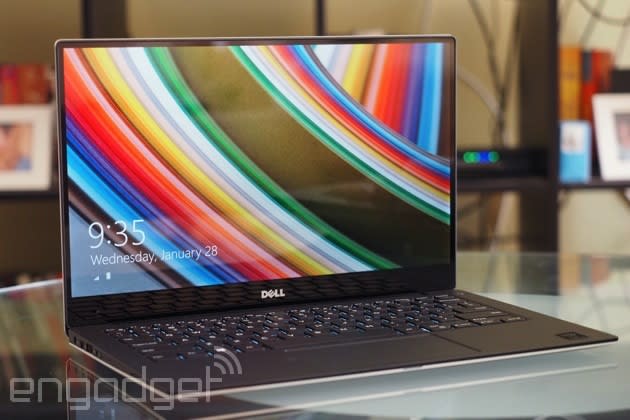
Dell's marketing team has taken the liberty of calling the XPS 13's screen an "infinity display." While that's technically incorrect -- you can still make out the 5.2mm-thick bezels on either side -- this is perhaps the closest thing I've seen to a true edge-to-edge display, with pixels stretching all the way across. Also, the screen here has the tiniest bumper you ever did see, which also helps create the illusion of uninterrupted glass. In any case, it's all very pretty, as you'd expect, and it's practical too: You get the same real estate as any other 13-inch laptop, just with a smaller footprint.
Dell didn't skimp on the display quality either. The IPS Gorilla Glass screen (which starts at 1080p resolution, but goes up to 3,200 x 1,800) offers wide viewing angles, which came in handy during my six-hour flight from New York to Seattle. Even with the window open and sunlight pouring in, I could still make out the screen without issue. Also, given that I was trapped in economy, I didn't exactly have much space to work with. Still, whether I had the machine in my lap or balanced on the tray table with the lid dipped forward, I enjoyed bright colors and even contrasts. No washouts here. My only complaint? The XPS 13 doesn't come standard with a touchscreen; for that feature, you'll need to pay $1,300, not $800. Boo.
It's easy to miss the XPS 13's stereo speakers the first time you pick it up: They're nestled on either side of the laptop, toward the front where the chassis gets really narrow. While the audio might seem like an afterthought, it's actually surprisingly good -- among the best in its class, even. The volume is strong enough that I typically didn't need to push it much beyond the 30 out of 100 mark. And while this isn't the most bass-heavy setup you've ever heard (why would it be?), the speakers stand up well to a wide variety of musical genres, from classical to jazz to hip-hop and pop. All told, even when I needed to go back to my "real" laptop for certain things, I continued to use the XPS 13 as my music machine.
Performance, battery life and software
PCMark7 | 3DMark06 | 3DMark11 | ATTO (top disk speeds) | |
|---|---|---|---|---|
Dell XPS 13 (2015, 2.2GHz Intel Core i5-5200U, Intel HD 5500) | 4,900 | 7,433 | E2,114 / P1,199 / X330 | 515 MB/s (reads); 455 MB/s (writes) |
Lenovo Yoga 3 Pro (1.1GHz Intel M-5Y70, Intel HD 5300) | 4,699 | 4,734 | E1,076 / P595 / X175 | 554 MB/s (reads); 261 MB/s (writes) |
Samsung ATIV Book 9 2014 Edition (1.6GHz Core i5-4200U, Intel HD 4400) | 4,835 | 5,947 | E1,752 / P948 / X297 | 551 MB/s (reads); 141 MB/s (writes) |
Microsoft Surface Pro 3 (1.9GHz Core i5-4300U, Intel HD 4400) | 5,024 | 5,053 | E1,313 / P984 | 555 MB/s (reads); 252 MB/s (writes) |
Lenovo ThinkPad X1 Carbon (2014, 1.6GHz Core i5-4200U, Intel HD 4400) | 4,773 | 5,881 | E1,727 / P930 / X284 | 555 MB/s (reads); 137 MB/s (writes) |
Lenovo IdeaPad Yoga 2 Pro (1.6GHz Core i5-4200U, Intel HD 4400) | 4,676 | 5,688 | E1,713 / P914 / X281 | 546 MB/s (reads); 139 MB/s (writes) |
Samsung ATIV Book 9 Plus (1.6GHz Core i5-4200U, Intel HD 4400) | 4,973 | 5,611 | E1,675 / P867 / X277 | 547 MB/s (reads); 508 MB/s (writes) |
Acer Aspire S7-392 (1.6GHz Intel Core i5-4200U, Intel HD 4400) | 5,108 | 5,158 | E1,724 / P952 / X298 | 975 MB/s (reads); 1.1 GB/s (writes) |
Initially, I was mainly interested in testing the XPS 13 because of its compact design. Its gorgeous display. The fact that it nearly won a Best of CES Award. In addition to all that, though, this is my first opportunity to test a PC running one of Intel's new "Broadwell" chips. For the uninitiated, Intel's fifth-generation Core CPUs have the same basic architecture as last year's processors, except they've been shrunken down from a 22nm process to a 14nm one. Given that the chip design is generally the same, then, you should expect some fairly modest performance improvements. For instance, Intel is touting just a 4 percent boost in productivity tasks, as measured by the test SysMark. The company has also said battery life could be up to an hour and a half longer than on last year's "Haswell" machines, but even that's just a best-case scenario.
If anything, Broadwell has the most promise on the graphics front. Even before Broadwell PCs started hitting the market, Intel claimed that its new chips performed 22 percent better than last year's models in 3D graphics benchmarks. Indeed, about two-thirds of the die area on these chips is dedicated to graphics. Sure enough, with a dual-core 2.2GHz Core i5-5200U CPU and 8GB of RAM (a configuration worth $1,300), I saw huge gains in every test I ran -- just look at the comparison table above if you don't believe me. By the same measure, general performance, as measured by PCMark, was only slightly improved over machines running last year's processors. Its 10-second boot-up is also par for the course.
Although my particular test unit included a 128GB solid-state drive from LiteOn, a Dell spokesperson told me that some machines will instead make use of a fast new Samsung drive that claims up to 2.15 GB/s read and 1.55 GB/s write speeds, all while sipping just two milliwatts of standby power. While I was a little disappointed not to find that listed in my machine's Device Manager, I still enjoyed some fast disk speeds, with up to 515 MB/s reads and 455 MB/s writes. That last figure -- the write rate -- is especially impressive: Though many laptops can get into 500 MB/s territory for read speeds, most top out in the mid-200 MB/s range on writes. So, Samsung or no Samsung, you should enjoy some better-than-average performance here, at least as far as disk speeds are concerned.
Battery life | |
|---|---|
Dell XPS 13 (2015) | 7:36 |
MacBook Air (13-inch, 2013) | 12:51 |
MacBook Pro with Retina display (13-inch, 2013) | 11:18 |
Samsung ATIV Book 9 (2014 Edition) | 9:48 |
Samsung ATIV Book 9 Plus | 8:44 |
HP Spectre 13 | 8:30 |
Lenovo Yoga 3 Pro | 7:36 |
Acer Aspire S7-392 | 7:33 |
Samsung Series 9 (15-inch, 2012) | 7:29 |
Microsoft Surface Pro 3 | 7:08 |
Lenovo Yoga 2 Pro | 6:32 |
Lenovo ThinkPad X1 Carbon (2014) | 6:18 |
Depending on your usage patterns, Dell says you can get up to 15 hours of battery life with a full HD display, and up to 11 hours with a 3,200 x 1,800 touch panel. On my test unit, which had a 3,200 x 1,800 touchscreen, I got an average of seven hours and 36 minutes in our standard video-looping test, though I bet I could have squeezed out even more runtime had I lowered the brightness to an even dimmer setting (the panel goes all the way up to 400 nits, so even half or three-quarter brightness can drain the battery fairly quickly). It should go without saying too, that models with a lower-res 1080p screen will probably have longer runtime, just because there are fewer pixels to light up.
In any case, the new XPS 13 represents a tremendous improvement over the original version from 2012, which could barely crack five hours (and that was with a lower-resolution screen, too). Just as important, the XPS 13's battery life matches other thin-and-light machines we've tested recently, including the Lenovo Yoga 3 Pro and Acer Aspire S7. The fact is, for a laptop that's this thin and this light with that pixel-dense a screen, getting eight hours on a charge is pretty respectable. And again, I suspect it's actually capable of lasting even longer than that.
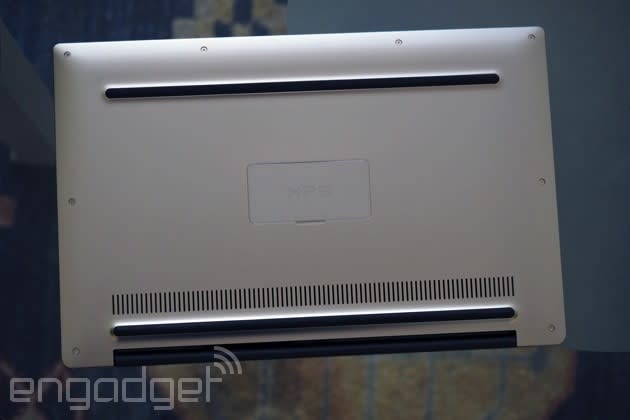
Should the built-in battery not be enough, Dell also sells a spare, 12,000mAh cell for $120 that plugs into the laptop's power port, much the same way you'd use a mobile charger to refuel a phone or tablet. All told, Dell claims that the Power Companion, as it's called, can help the XPS 13 reach 22 hours of battery life. That's impressive, to be sure, and it's also more convenient than swapping out your notebook's built-in battery or attaching a cumbersome sheet to the bottom. As a bonus, the charger also has two USB ports for charging mobile devices, which means you could potentially travel with just one adapter for all your gadgets.
As for bloatware, Dell may have once had a reputation for loading its Windows PCs up with unwanted programs, but the manufacturer has apparently turned over a new leaf. There's very little here in the way of superfluous apps; just Flipboard, Microsoft's own Bing Translator and 20GB of Dropbox storage, free for one year. There's also a trial of McAfee LiveSafe Internet Security and Microsoft Office (activation key required). And... that's it.
Configuration options
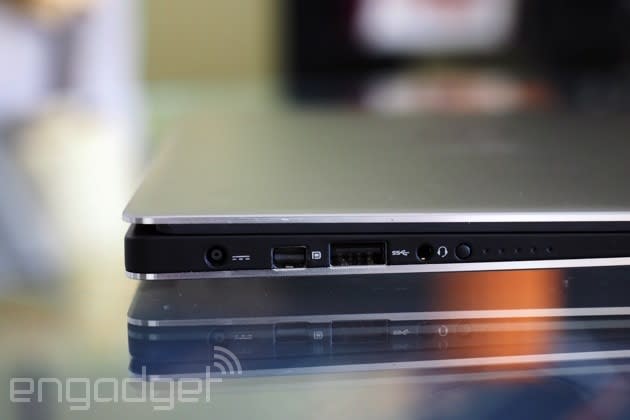
The XPS starts at $800, with base specs that include an Intel Core i3-5010U Broadwell processor, 4GB of RAM, a 128GB SSD, Intel HD 5500 Graphics and a matte (non-glare) 1,920 x 1,080 screen. As I hinted earlier, though, that low starting price is slightly disingenuous when you remember it doesn't come standard with a touchscreen. Not that you need one, per se, but many users will want one, especially considering how touch-optimized Windows 8 is (and Windows 10, when it comes out). If you do want that 3,200 x 1,800 touch panel, be prepared to pay at least $1,300.
In addition, you'll find some mid-range configurations that give you the Core i5 processor with a 1080p screen with either 4GB or 8GB of RAM. Throughout the line too, there are configurations with larger 256GB solid-state drives. At the higher end, Dell is even offering a couple Core i7 configs, one of which has a 512GB SSD. That top-of-the-line model goes for $1,900. All in all, then, you've got a lot of customization options -- more than on most Ultrabooks, in fact.
The competition
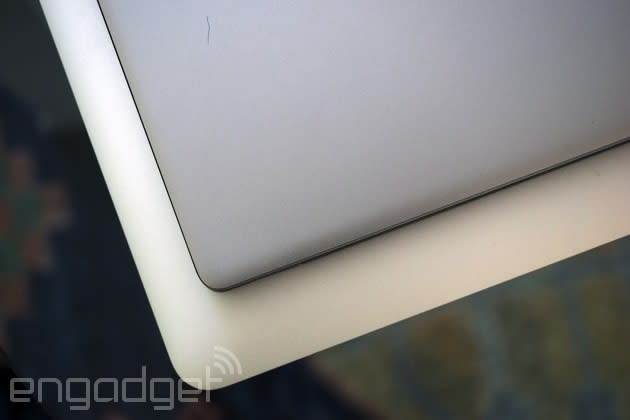
The Dell XPS 13 is going to be a smart buy for many, many people. But it's also in good company: I can think of several other ultraportables you'd probably be happy to own. For starters, there's Lenovo's convertible Yoga 3 Pro ($1,299-plus), which measures just half an inch thick and weighs only 2.62 pounds -- crazy light for a machine with a 360-degree hinge. The only potential downside is that it runs one of Intel's low-powered "Core M" chips, which aren't quite as robust as fifth-generation Core processors. If you need a little more oomph, Lenovo is also readying a 1.7-pound laptop -- the world's lightest 13-inch PC, in fact -- which, despite its dainty frame, will run full-fledged Core CPUs. The only thing is: It's not shipping until May, which could be a problem if you need a new notebook now.
There are a couple other options too, but I haven't had a chance to test all of them. One is the new Samsung ATIV Book 9, a 12.2-inch, fanless machine that uses a Core M processor to achieve a thin design. Of note: It comes standard with a 2,560 x 1,600 screen that goes all the way up to an impressive 700 nits of brightness. Aside from the lower-powered processor, the only real concession seems to be that machine isn't offered with a touchscreen.
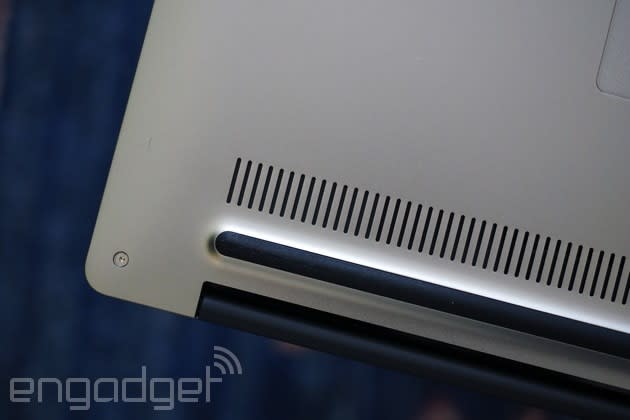
Meanwhile, some of our favorite Ultrabooks have been refreshed with Broadwell processors, theoretically bringing them in line with newer machines like the XPS 13. These include Acer's Aspire S7 ($1,300-plus) and Samsung's ATIV Book 9 Plus ($1,299-plus). Microsoft's Surface Pro 3 actually hasn't been updated with Broadwell, but it's nonetheless a well-built, thin and light tablet that more or less matches the XPS 13 on battery life. If you mainly want a laptop, a proper Ultrabook is still your best bet. But if you want the option of using your device in tablet mode, both the Surface Pro 3 and the Lenovo Yoga 3 Pro are good choices.
And what of the MacBook Air, which I keep comparing to Dell's new machine? I'm sure there are some folks out there who insist on OS X, and probably aren't giving serious consideration to the XPS 13 (or any Windows machine, for that matter). Even if you are Mac-leaning, though, you'd be doing yourself a disservice if you bought an Air now. Don't get me wrong: It's a well-built machine with long battery life, but it's also sorely in need of an update. As of this writing, Apple hasn't refreshed it with fifth-generation Core processors. And that's not even taking into account that a new, drastically smaller device might be in the works. If you think you want an OS X-based machine, I'd suggest you wait, if possible.
Wrap-up

There's a reason the XPS 13 was a Best of CES finalist: It's not only one of the top laptops we saw at the show, but also one of the finest PCs we're likely to see for months to come. If you're in the market for a new Windows laptop -- something small and light with fast performance and a great screen -- this should absolutely be on your short list. There are other fine choices too, as I've laid out in the previous section, but the XPS 13 is a winner its own right, with very few flaws to speak of. The only things I'd caution you of are the touchpad (it needs a little work) and the battery life, which is merely average, at least on the touch edition. Speaking of, it's on the pricey side if you do indeed configure it with a touchscreen. Even then, though, the $1,300 asking price is worth it.




























